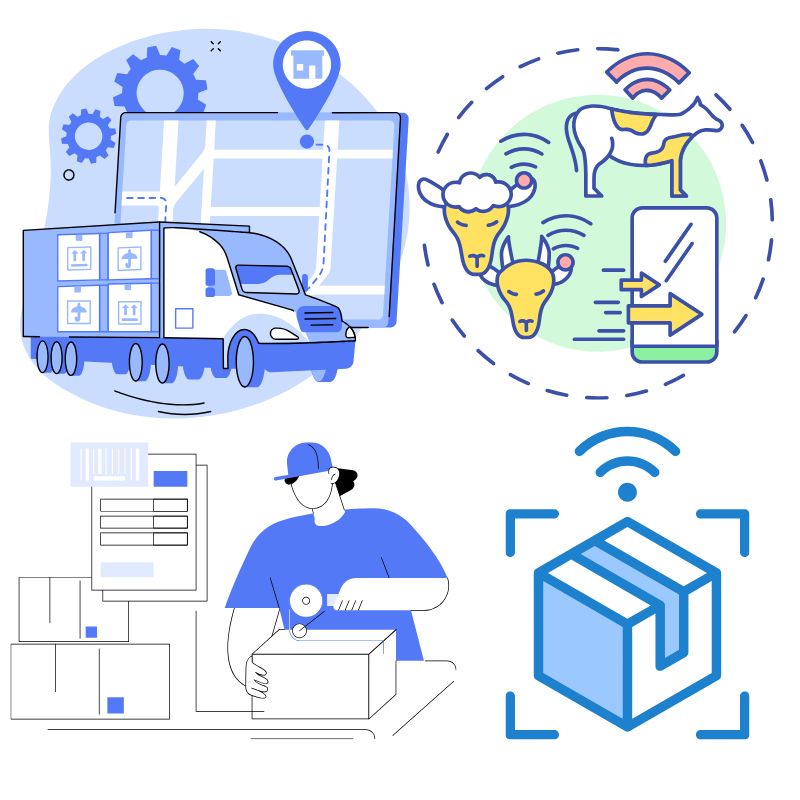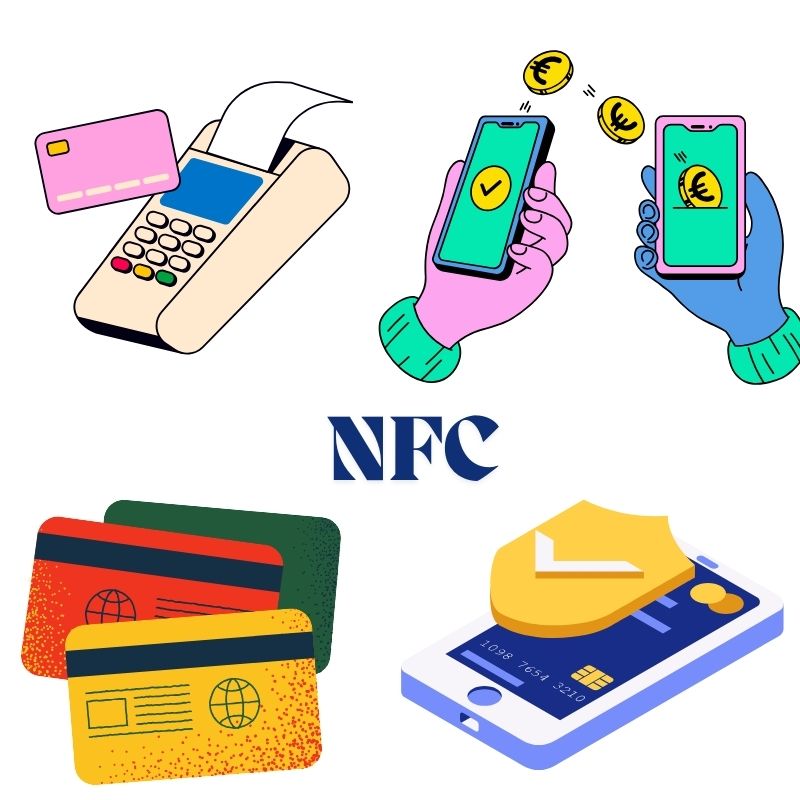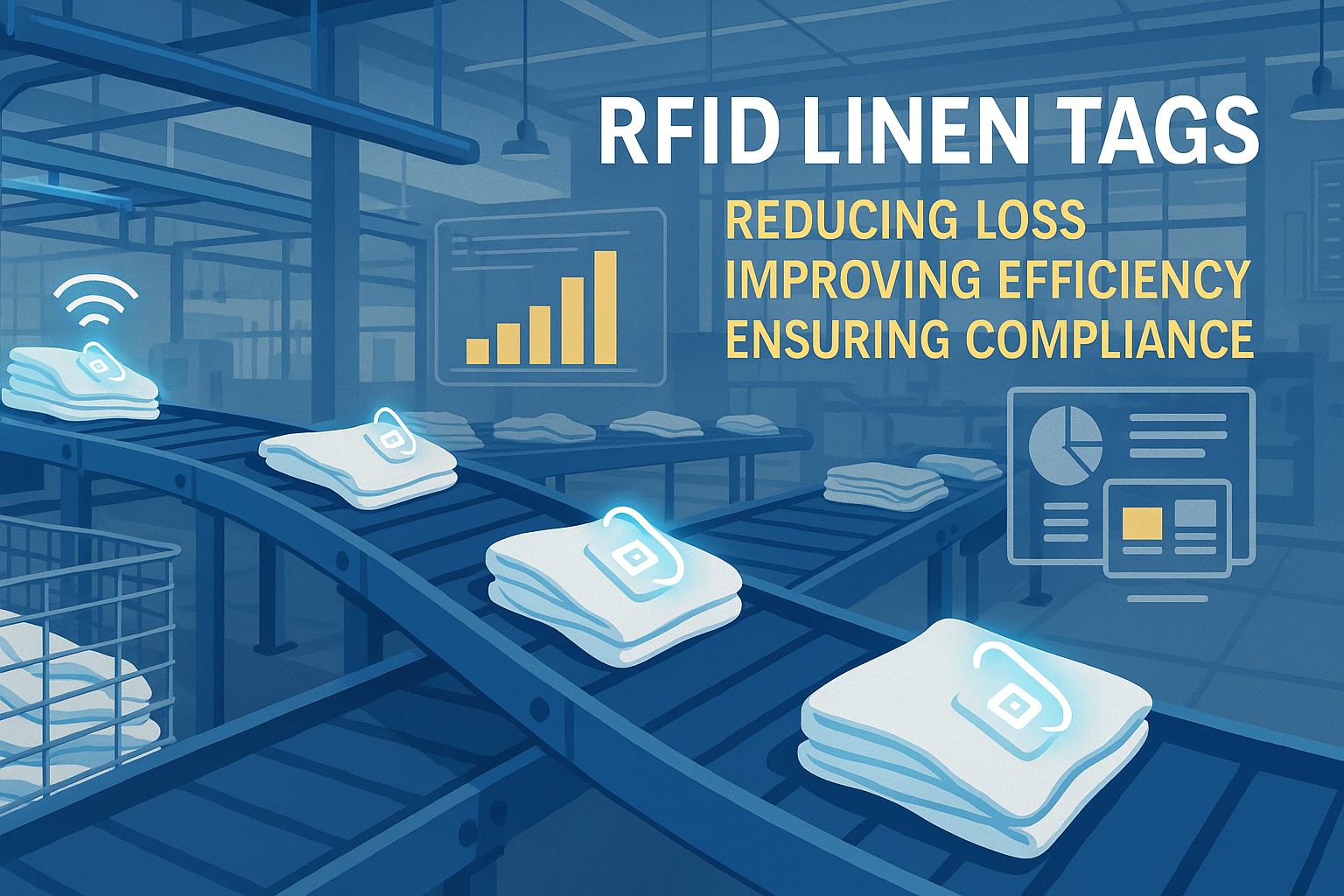
Vad är skillnaden mellan NFC och RFID?
Innehållsförteckning
NFC och RFID: Viktiga skillnader, tillämpningar och vilket man ska välja (guide för 2025)
Från lageruppföljning till kontaktlösa betalningar – dessa trådlösa kommunikationsmetoder hjälper branscher att automatisera processer, minska fel och förbättra säkerheten.
Denna guide förklarar skillnaden mellan RFID och NFC, hur de fungerar, deras tillämpningar och vilken som passar dina behov bäst år 2025.

Vad är RFID och NFC?
RFID (identifiering med radiofrekvens)
RFID använder radiovågor för att automatiskt identifiera och spåra objekt genom RFID-taggar och RFID-läsare. Det används ofta inom branscher som logistik, detaljhandel, tillverkning och hälso- och sjukvård för att spåra tillgångar och effektivisera leveranskedjan.
- Frekvensband: Lågt (LF), högt (HF) och ultrahögt (UHF)
- Läsavstånd: Upp till 100 meter (aktiva taggar)
- Taggar: Passiv (utan batteri) eller aktiv (batteridriven)
- Användningsfall: Lagerhantering, spårning av tillgångar, åtkomstkontroll
NFC (närområdeskommunikation)
NFC är en specialiserad delmängd av RFID som arbetar vid 13,56 MHz (HF). Till skillnad från allmän RFID möjliggör NFC tvåvägskommunikation mellan enheter på mycket nära avstånd – vanligtvis under 4 cm. Det används ofta för säker och snabb datautbyte, till exempel mobila betalningar eller digitala visitkort.
- Frekvensband: Högfrekvens (13,56 MHz)
- Räckvidd: Inom några centimeter
- Interaktivitet: Stöder tvåvägskommunikation
- Användningsfall: Kontaktlösa betalningar, smartphone-parkering, kollektivtrafik
NFC vs RFID: Vad är skillnaden?
Skillnaden mellan RFID och NFC ligger i räckvidd, interaktivitet, effekt och tillämpningar. Här är en snabb jämförelsetabell:
| Särdrag | RFID | NFC |
|---|---|---|
| Frekvensband | LF, HF, UHF | HF (13,56 MHz) |
| Läs Range | Upp till 100 meter | Inom några centimeter |
| Kommunikation | Enkelriktad (för det mesta) | Tvåvägs |
| Strömkälla | Passiv eller aktiv | Vanligtvis passiv |
| Ansökningar | Lager, leveranskedja, åtkomstkontroll | Mobila betalningar, datadelning |
| Interaktivitet | Låg | Hög (interaktion mellan användare och enhet) |
- “RFID är idealiskt för spårning av tillgångar i stor skala, medan NFC är utformat för säkra interaktioner på kort avstånd, såsom mobila betalningar.”
Hur RFID-teknik fungerar
Ett RFID-system bygger på tre huvudkomponenter:
- RFID-taggar: Lagrar artikelinformation (kan vara skrivskyddad eller läs- och skrivbar).
- RFID-läsare: Sänder ut en signal för att driva passiva taggar och hämta data.
- Mjukvarusystem: Tolkar och hanterar insamlade data.
Typer av RFID-taggar
- Passiva RFID-taggar: Inget internt batteri, drivs av RFID-läsarens signal.
- Aktiva RFID-taggar: Har egen strömkälla för längre räckvidd och frekventa datauppdateringar.
RFID- och NFC-läsare finns i handhållna och fasta format, beroende på tillämpningen.
Hur NFC fungerar
NFC-tekniken möjliggör kommunikation på nära håll mellan två NFC-kompatibla enheter eller mellan en enhet och en NFC-tagg.
Fördelar med NFC:
- Enkelhet med Tap-and-Go: Ingen parkoppling eller skanning krävs.
- Hög säkerhet: Idealisk för kontaktlösa finansiella transaktioner.
- Tvåvägskommunikation: Till skillnad från de flesta RFID-system kan data flöda i båda riktningarna.
NFC- och RFID-läsare integreras i allt högre grad i smartphones, POS-terminaler och transitportar för snabba, tillförlitliga och säkra interaktioner.
Tillämpningar av RFID
RFID och NFC används båda i olika applikationer, men RFID:s långa räckvidd och flexibilitet gör det idealiskt för:
Lagerhantering
- Uppdateringar i realtid
- Automatiserad spårning mellan lager
Spårning av tillgångar
- Övervaka medicinsk utrustning, verktyg eller fordon
- Öka effektiviteten inom logistik och hälso- och sjukvård
Åtkomstkontroll
- Använd RFID-nyckelkort, nyckelbrickor eller ID-kort
- Kontrollera tillträdet till säkra byggnader eller zoner
Tillämpningar av NFC
NFC:s säkra och kortdistansfunktioner kommer till sin rätt i personliga och offentliga applikationer:
Mobila betalningar
- Apple Pay, Google Pay, Samsung Pay.
- Säkra transaktioner på några sekunder.
Smarta enheter och marknadsföring
- Tryck för att starta appar eller dela kontaktinformation.
- Smarta taggar för produktinformation eller incheckningar.
Transportsystem
- Kontaktlösa resekort.
- Enkel påstigning i tunnelbanan och bussnätet.

NFC eller RFID: Vilket ska du använda?
| Användningsfall | Bästa tekniken |
|---|---|
| Långdistansspårning | RFID |
| Lager- eller leveranskedjeverksamhet | RFID |
| Säkra, personliga transaktioner | NFC |
| Mobila betalningar och ID | NFC |
| IoT smart automatisering | Både |
Om du hanterar tusentals tillgångar är RFID det självklara valet. För enskilda, säkra interaktioner – som att trycka på din telefon – är NFC det självklara valet.
NFC och RFID i IoT (sakernas internet)
RFID och NFC är grundläggande för IoT-ekosystem, eftersom de gör det möjligt för fysiska objekt att “kommunicera” med digitala system.
- RFID i IoT: Övervakar varor i leveranskedjor och tillverkningslokaler.
- NFC i IoT: Möjliggör säker enhetsparning, smart hemåtkomst och realtidsstyrning via smartphones.
“Kombinationen av NFC- och RFID-taggar förändrar IoT genom att koppla fysiska tillgångar till molnet.”
Frekvensens roll i NFC- och RFID-prestanda
Att förstå frekvensen hjälper dig att välja rätt system:
- LF (125–134 kHz) – Kort räckvidd, används för åtkomstkontroll
- HF (13,56 MHz) – Används av både RFID och NFC
- UHF (860-960 MHz) – Lång räckvidd, idealisk för leveranskedjor
Varje frekvens stöder olika intervall och läshastigheter, vilket gör valet av RFID- och NFC-läsare viktigt för systemets prestanda.
Vanliga frågor om NFC och RFID
Vad är den största skillnaden mellan RFID och NFC?
NFC är en delmängd av RFID. Medan RFID stöder längre räckvidd och enkelriktad kommunikation, är NFC utformat för dubbelriktad interaktion på kort avstånd.
Kan NFC- och RFID-taggar användas omväxlande?
Inte alltid. NFC fungerar endast på HF, medan RFID kan använda LF, HF eller UHF. NFC-taggar fungerar endast med NFC-läsare, inte alla RFID-läsare.
Är RFID-taggar säkra?
Passiva RFID-taggar kan vara sårbara utan kryptering. NFC erbjuder mer inbyggd säkerhet, särskilt för finansiella transaktioner.
Vad är en NFC- och RFID-läsare?
Det är en enhet som används för att läsa RFID- eller NFC-taggar. Många moderna smartphones fungerar som NFC-läsare för kontaktlösa åtgärder.
Hur fungerar NFC-aktiverade betalningar?
Enheterna använder NFC för att överföra krypterad betalningsinformation trådlöst till kompatibla terminaler – utan fysisk kontakt.
Vilka branscher drar mest nytta av RFID?
Detaljhandel, hälso- och sjukvård, logistik, tillverkning och lagerhantering använder RFID för automatisering och synlighet.
Slutliga tankar
Både RFID och NFC erbjuder betydande värde – oavsett om du spårar pallar eller gör betalningar med din smartphone. Ditt val bör anpassas efter dina operativa behov:
- För bred, automatiserad spårning, välj RFID.
- För säkra interaktioner på kort avstånd, välj NFC.
RFID- och NFC-taggar utvecklas i takt med IoT, och nu är det perfekta tillfället att integrera dem i ditt arbetsflöde.
Behöver du hjälp med att välja rätt NFC- eller RFID-system för ditt företag?
Kontakta oss idag eller utforska vårt kompletta sortiment av NFC- och RFID-läsare och taggar.

Ray Zhou
Den här artikeln skrevs av Ray Zhou, en RFID-teknikexpert med mer än 10 års branscherfarenhet.
Kommentarer
Heta produkter

Vad är RFID-avfallshantering?
Föreställ dig en stad där varje sopkärl talar – inte bokstavligt talat – utan genom ett litet chip som meddelar systemet när det är fullt, när det töms och vart det har tagits. Det är vad RFID-avfallshantering gör idag.

Vad är bultförseglingar och deras användningsområden? | Komplett guide
Inom global handel och logistik spelar bultförseglingar en avgörande roll för att säkerställa godssäkerhet och efterlevnad. Dessa små men kraftfulla enheter är utformade för att låsa fraktcontainrar, släpvagnar och lastdörrar med en manipuleringssäker mekanism.

Vad är ett RFID-kortskydd? Fördelar, användningsfall och köpguide
RFID-teknik (Radio Frequency Identification) finns överallt: i dina kreditkort, ID-brickor, färdbevis, hotellrumsnycklar och mycket mer. Det ger snabbhet och bekvämlighet, men det öppnar också dörren för en ny typ av digital stöld som kallas "skimming". Det är där ett RFID-kortskydd kommer in i bilden.

RFID-armband för evenemang: Guide för storköp för arrangörer
RFID-armband för evenemang håller på att bli lösningen för arrangörer som behöver snabbare inträde, bedrägeribekämpning och kontantlösa betalningar på konserter, festivaler och idrottsarenor. Till skillnad från pappersbiljetter eller QR-koder använder dessa smarta armband inbäddade chips för att effektivisera åtkomst, säkra transaktioner och förbättra gästupplevelsen.

Hur RFID-taggar på vindrutan förbättrar passerkontroll och vägtullsystem för fordon
I dagens snabba värld måste fordonsidentifiering vara snabb, säker och kontaktlös. En RFID-tagg på vindrutan ger exakt det - ett tillförlitligt sätt att hantera vägtullar, parkering och gated access utan att stoppa fordon.

Fördelarna med RFID-linnetiketter i kommersiella tvätterier
Att hantera tvätten på sjukhus, hotell eller stora tvätterier är ett stort jobb. Varje dag tvättas, sorteras och skickas tusentals lakan, handdukar och uniformer tillbaka ut. Men problem som borttappade sängkläder, sorteringsmissar och manuell räkning kan kosta företagen mycket pengar. Till exempel kan medelstora hotell förlora över $200.000 varje år på grund av borttappade sängkläder.
Det är där RFID Linen Tags kommer in i bilden.
Taggar
RELATERADE BLOGGAR

Vad är RFID-avfallshantering?
Föreställ dig en stad där varje sopkärl talar – inte bokstavligt talat – utan genom ett litet chip som meddelar systemet när det är fullt, när det töms och vart det har tagits. Det är vad RFID-avfallshantering gör idag.

Vad är bultförseglingar och deras användningsområden? | Komplett guide
Inom global handel och logistik spelar bultförseglingar en avgörande roll för att säkerställa godssäkerhet och efterlevnad. Dessa små men kraftfulla enheter är utformade för att låsa fraktcontainrar, släpvagnar och lastdörrar med en manipuleringssäker mekanism.

Vad är ett RFID-kortskydd? Fördelar, användningsfall och köpguide
RFID-teknik (Radio Frequency Identification) finns överallt: i dina kreditkort, ID-brickor, färdbevis, hotellrumsnycklar och mycket mer. Det ger snabbhet och bekvämlighet, men det öppnar också dörren för en ny typ av digital stöld som kallas "skimming". Det är där ett RFID-kortskydd kommer in i bilden.




